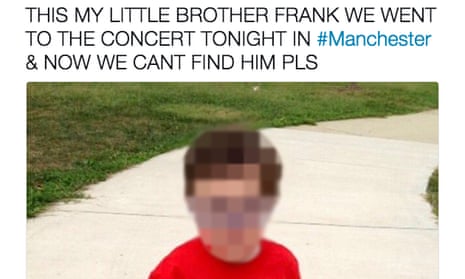The tweets usually go something like this.
“My son was in the Manchester Arena today he’s not picking up my call”
“Help my sister is missing in #Munich, she was working in Mcdonalds when the shooting started”
“My sister was in #Nice near the accident, please help, my mama is crying”
The posts all have something in common – they were all sent after an attack in a European country and were all fake. Attached to each was a picture of someone who wasn’t at the scene; some weren’t even in the same country.
In the wake of the Manchester attack, family members of people genuinely caught up in Monday night’s terror searched desperately for news of their loved ones. Many turned to social media. Collages of the missing were created by people who wanted to help.
But as their posts went viral, so did the hoaxes. And this time, some ended up being published by major news outlets in the media scramble which traditionally follows a terrorist attack.
‘I felt violated’
Rachel Devine had just come out of surgery when she received a message from a friend asking if her daughter Gemma was OK. Someone had seen a post claiming she was at the concert.
This was strange, because Devine knew Gemma was not in Manchester; she was at her school in Melbourne, Australia.
“I was actually recovering from surgery so unable to respond quickly,” Devine said. “I can only assume that in the rush to get ‘the story’, news producers found the image and plea for help and ran with it. Her face was all over the Daily Mail in their ‘breaking coverage’.”
Gemma’s picture was included in the collages of victims which Devine said she had seen everywhere, even on the Facebook pages of Australian breakfast TV shows.
“Gemma was initially confused, as one can imagine,” said Devine. “She is only concerned about the people who were actually lost in the tragedy and their families, and that people understand that she had absolutely nothing to do with the false spread of her image.”
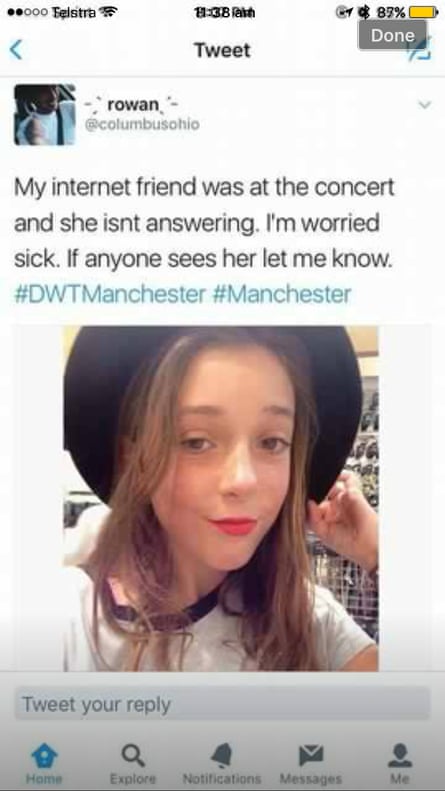
As a blogger, Devine said she was used to people stealing her images and those of her children. “I often hear from ‘trolls’ about how terrible I am to expose my children to such risks by sharing their images online or allowing my kids to share their own images online, but my family will not live our life in fear.
“That is our choice on how we will experience life and connect with others.”
Meanwhile, in Ohio, Karen Bowersox was watching in horror as the retweets racked up of a photo of a young boy who had modelled for her clothing range for children with Down’s syndrome.
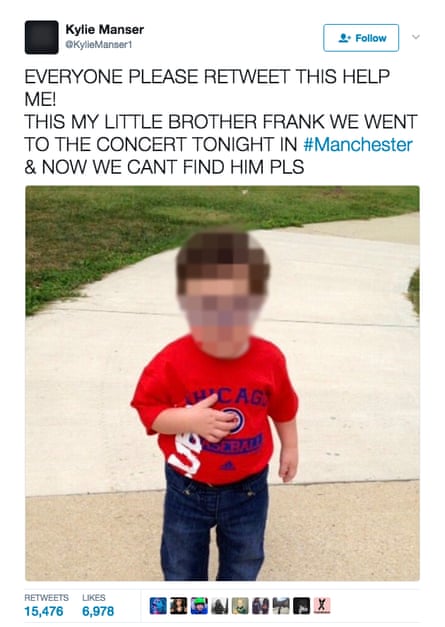
“I have this loving business and then someone takes this beautiful little child’s picture and exploits this child,” she said. “I tried to call the mother but I couldn’t get a hold of her. I’m worried about how she must be feeling about all that.”
Bowersox said she received calls and emails from people who believed she was responsible for the post. “There was one from this lady who said she was going to report our website, she thought probably it was our company or something that had done this.
“I sent her a nice explanation and explained the picture was out there and we certainly had nothing to do with exploiting this little boy. I felt terrible, just terrible.”
Her other concern was that people would use this image to try to set up fraudulent fundraising accounts. “This guy could have maybe got money for all this, saying ‘my poor brother’. “He could have elaborated a very intense story over this had people not found out.”
Bowersox and Devine’s immediate thoughts were of the real victims and their family members. “I am heartbroken for those parents who were doing something fun for their kids by taking them to Ariana Grande’s show and were left with such tragedy,” said Devine.
‘This thing will stop happening when the media starts doing basic research’
It’s tricky trying to get some of the posters to talk. The account @kyliemanser1, which tweeted the picture of the young boy, didn’t answer a request for comment. It has since been suspended for violating Twitter’s rules. Another account, which seemed to have used a picture of someone as a toddler in the 1990s, maintained their innocence.
When the Guardian pressed them to admit it was a fake post, they replied: “You have been reported for harassing the family of a victim. Theyll [sic] be a knock at your door.”
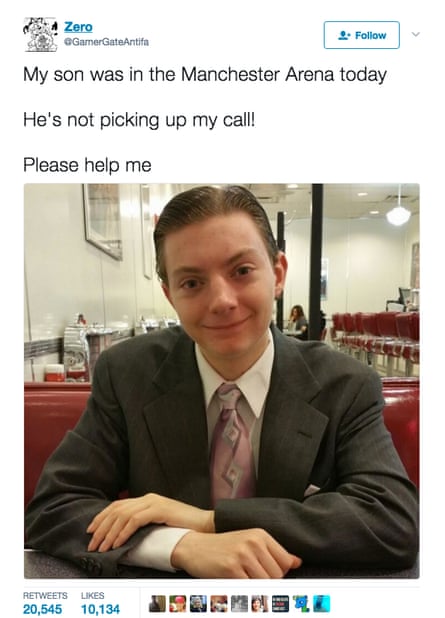
One person did agree to explain the thinking behind this form of trolling.
@Gamergateantifa told the Guardian it was mainly about fooling the media. “It has become sort of a competition of who can fool the news. The only way to give it enough ‘credibility’ is to fool a lot of people.”
The trend started, @Gamergateantifa claims, with a well-known hoax involving Sam Hyde, a comedian with a history of pranks. Social media users would use photos of him after any breaking news involving a shooting or a terrorist attack, usually attempting to fool the media into thinking he was the perpetrator.
“People see something on social media and instantly think it’s true. Let’s say you saw a tweet, would you take a look at my profile first before making any decisions about spreading it?
If you did, you would find out I was lying instantly.”
@Gamergateantifa’s hoax tweet involved TheReportOfTheWeek, a YouTuber with more than 22,000 subscribers, who ended up making a video to say he was alive and not in Manchester.
It was a low effort tweet, because most of @Gamergateantifa’s followers knew who TheReportOfTheWeek was. Yet it still went viral.
Would @Gamergateantifa do it again? “I’m not gonna lie, I probably will. I can’t say whether I will get a result like this again. Someone else probably will, probably not.
“But the thing is, when this kind of thing stops happening is when the people or the media start doing basic research. Can’t say that’s a bad deal.”
‘They go on doing this as long as we the media believe them’
After every suspected terror attack for at least the last year, posts attempting to claim prominent internet celebrities or journalists are either a perpetrator or victim have appeared on Twitter.
It hasn’t been limited to terrorist attacks, either. After the EgyptAir crash in May 2016, the BBC reported on hoax victim posts, most of which originated in Mexico. Hoaxers later told journalists they used one man’s photo because he had cheated them out of money. “Our goal is to ruin his reputation. We want the whole world to recognise his face,” they told France 24’s The Observers.
Alastair Reid, a social media journalist at the Press Association, noticed the same photo circulating after the Brussels attack in 2016.
...find my bro/sis" but with a pic of minor celeb or athlete or random person. Preying on goodwill & tragedy for laughs. Such is webz 2/2
— Alastair Reid (@ajreid) July 18, 2016
Then, during the Nice attack, he noticed more. “There were probably about 15 to 20 different individuals identified by dozens of accounts as victims but they were all lies,” he said.
“There were celebrities, football players and just random people from social media. It’s been a feature of big, international breaking news situations ever since.”
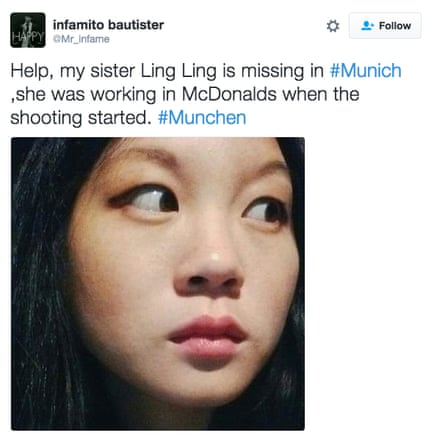
A trend within this trend is the targeting of female journalists. Susana Ye, a Spanish reporter, was targeted after an attack in Munich, when a teenager killed nine people in a shopping centre.
She was aware of the Mexican tweets but had no idea why her photo was dragged into it. “I am so not into the trolling world,” she said. “I think they go on doing this as long as we, the media, believe them. They feel like winners.”
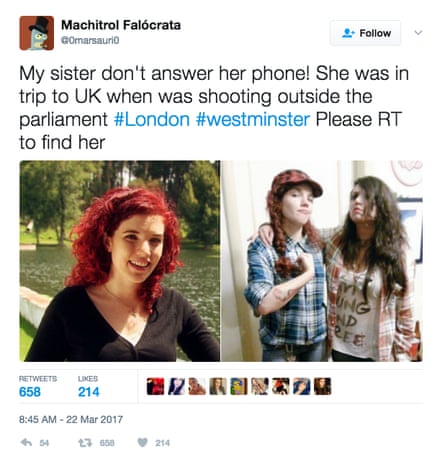
The Mexican journalist Tamara de Anda, who was the subject of hoax posts after the Westminster attack and again earlier this week, knows exactly why she is being targeted. In March, she was at the centre of her own social media storm after a taxi driver was fined for catcalling her.
“Trolls did what they do. All kinds of harassment: death threats, rape threats, everything.
“But after terrorist attacks from then on, they would post my picture. Whenever anything happens in Europe, they do it.
“The first time it happened, it was disturbing but now I feel bulletproof. It was something new, something I didn’t know they did. Luckily nobody who knows me thought it was real.”
She says she believes the whole thing has snowballed as more and more people are inspired by other viral hoaxes.
As "anti-feminazi" trolls report me missing in #Manchester, a misogynist radio host in #Mexico is harassing me live on air.
— Andrea Noel ϟ (@metabolizedjunk) May 23, 2017
—Coincidence? pic.twitter.com/OFeecKwNkA
Another journalist based in Mexico, Andrea Noel, was also mistakenly included in victim roundups after she was targeted by similar trolls.
While individual posts often get debunked in roundups of fake information during breaking news events, this was the first time this kind of trolling received widespread national coverage.
Reid said: “Misinformation has become a regularly discussed topic over the last six months.
“The groundwork has already been laid for hoaxers and liars on social media. And here we have people exploiting the deaths of children at a pop concert, seemingly for fun.
“Those circumstances make the ‘fake victim’ tweets particularly sickening.”
@KylieManser1 This photo has been stolen from our website. In the strongest terms we condemn the exploitation of children for any purpose.
— Downs Designs Dreams (@DwnsDesigns) May 23, 2017
‘Doesn’t Twitter have some kind of accountability?’
During the research for this article, many of the hoax tweets were taken down, or the accounts behind them suspended. But not all of them. There are some suspected fake accounts which even form part of news reports from earlier this week.
The Guardian contacted Twitter for clarification on their policy around this particular trend. They refused to comment.
De Anda thinks Twitter could do more, but doesn’t believe they will. “They’re worried about losing users. I think they know what to do, but they don’t want to do it.
“I report accounts and it just says: ‘Oh no, they’re not violating any rules. We cannot do anything’.
“This is something real that is happening to a lot of people and really affecting their lives. This doesn’t harm me, but it doesn’t mean it’s not bad for someone else.”
Bowersox doesn’t tweet, but she wonders the same thing.
“Wouldn’t Twitter have some kind of accountability to remove these things? This isn’t just a small thing,” she said. “Innocent people are being affected by this. Not maybe physically or monetarily – but certainly emotionally.”
